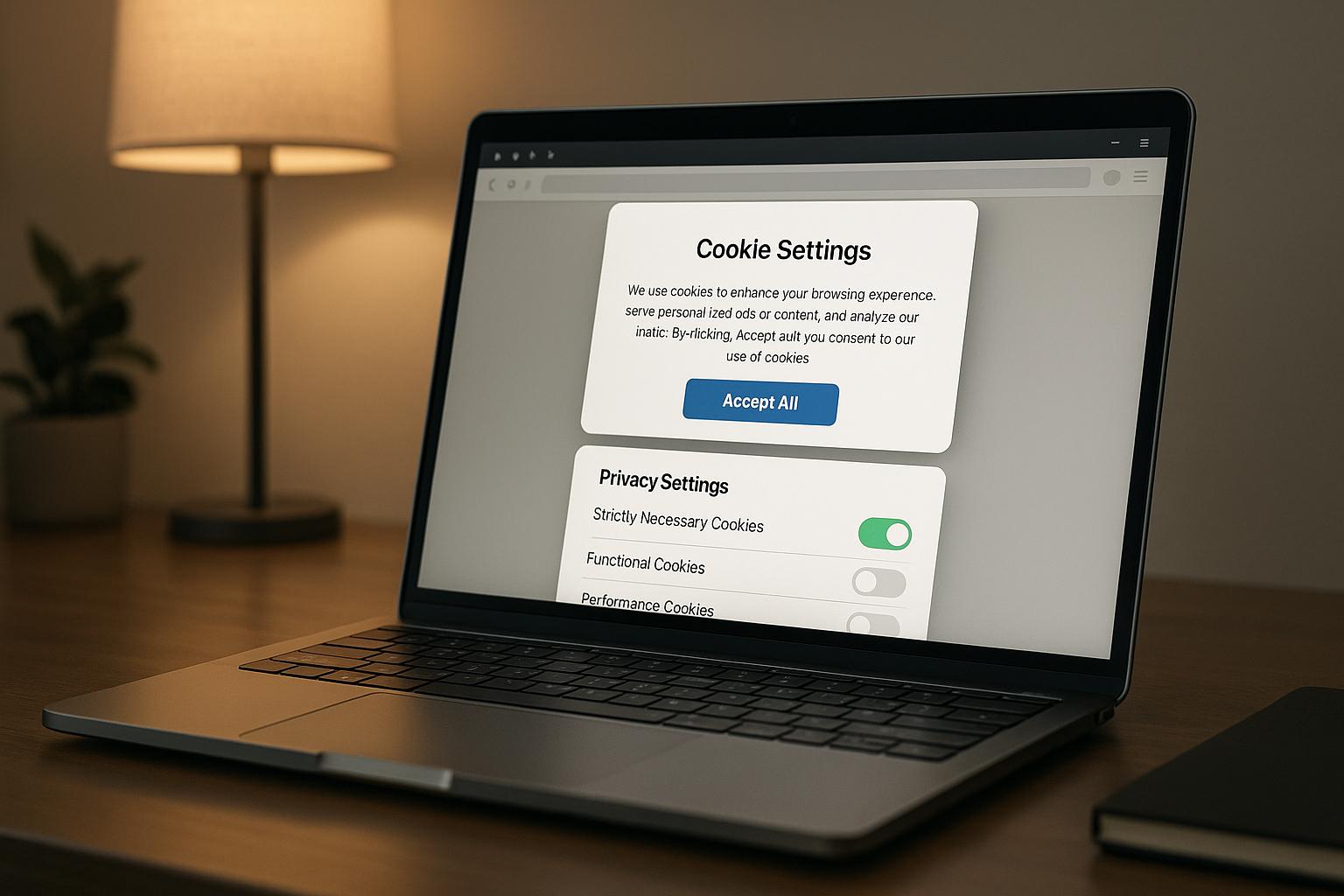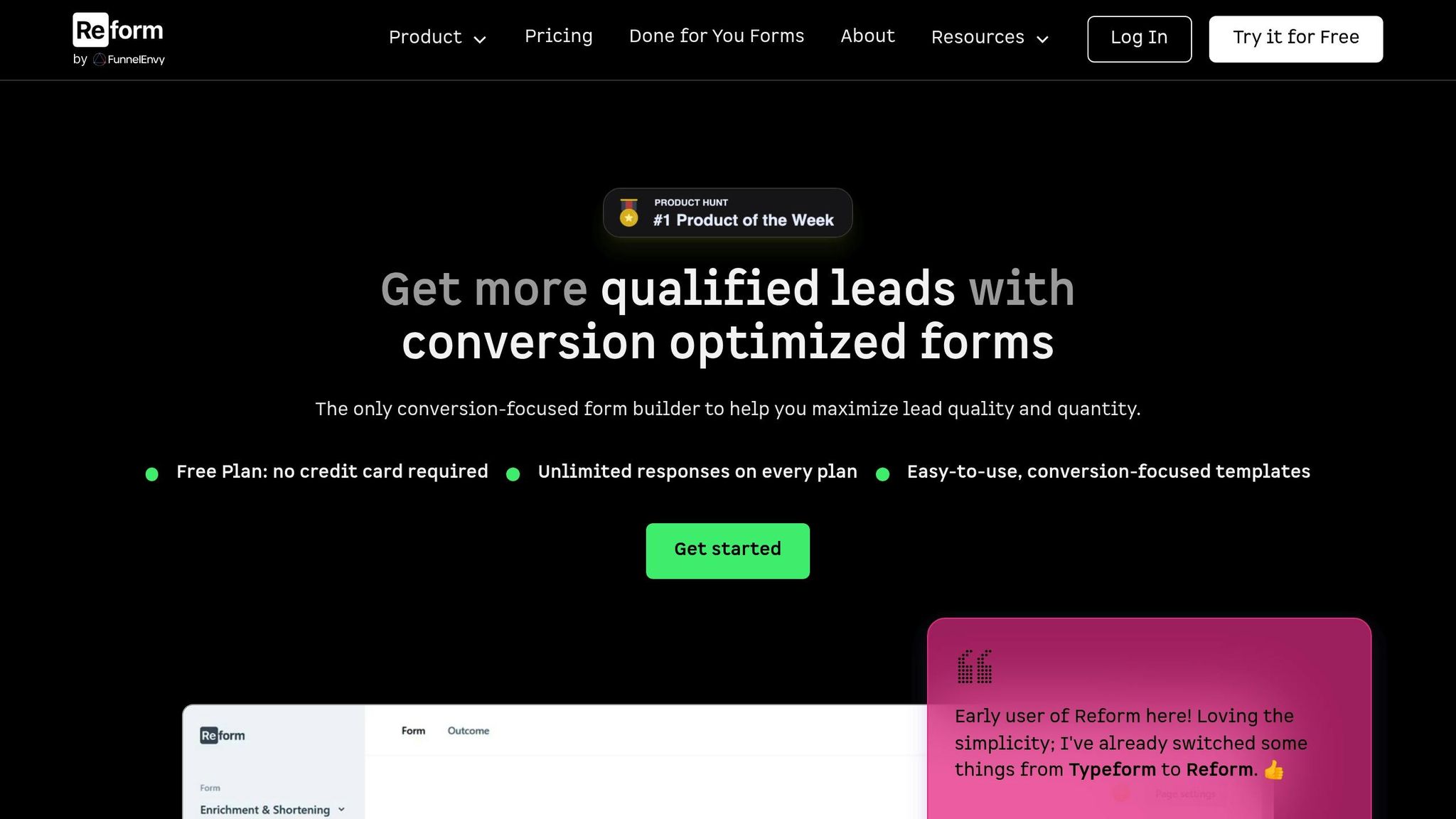Emerging Privacy Laws Impacting Tracking Cookies

Privacy laws are reshaping how businesses use tracking cookies. Regulations like GDPR in Europe and CCPA/CPRA in California now demand stricter consent, transparency, and user control over data collection. These laws primarily target third-party cookies, which track users across multiple sites, while first-party cookies face fewer restrictions. Non-compliance can lead to hefty fines, forcing businesses to rethink their data strategies.
Key takeaways:
- GDPR: Requires explicit opt-in consent for non-essential cookies. Transparency and granular control are mandatory.
- CCPA/CPRA: Focuses on opt-out mechanisms, with features like "Do Not Sell My Personal Information" links and honoring Global Privacy Control signals.
- Global Trends: Other regions, like Brazil (LGPD) and Canada (PIPEDA), are also tightening cookie regulations.
The growing restrictions on third-party cookies are pushing businesses to rely on first-party data and privacy-friendly approaches like contextual advertising. Tools like Reform help companies comply with privacy laws while maintaining effective lead generation through user-friendly, transparent forms.
The shift to privacy-first practices is no longer optional - it's the new standard.
Do US privacy laws require cookie banners? | Data privacy this week: September 4, 2024
Major Privacy Laws Affecting Cookie Use
The world of privacy laws is constantly changing, creating a challenging environment for businesses to navigate. Different regulations enforce varying rules for cookie consent, and understanding these frameworks is essential. Let’s break down some of the key privacy laws, starting with Europe’s GDPR.
GDPR: Europe’s Privacy Framework
Introduced in 2018, the General Data Protection Regulation (GDPR) has become the gold standard for cookie-related privacy rules. Under GDPR, businesses must obtain explicit opt-in consent before using any non-essential cookies. This means users have to actively agree to cookies - no more pre-checked boxes or automatic enrollment.
Transparency is a cornerstone of the GDPR. Websites are required to clearly explain what types of cookies they use and why. Additionally, users must be given granular control, allowing them to consent to specific types of cookies rather than a blanket "all or nothing" approach. Importantly, GDPR also gives users the right to withdraw consent at any time, so businesses need to make it simple for users to update their cookie preferences.
Non-compliance isn’t cheap - companies face fines of up to €20 million or 4% of their annual global revenue, whichever is higher. These strict rules have made GDPR a model for privacy laws worldwide.
CCPA and CPRA: California’s Privacy Approach
California’s privacy laws, including the California Consumer Privacy Act (CCPA) and its updated version, the California Privacy Rights Act (CPRA), take a different route. Instead of requiring an opt-in system like GDPR, California laws use an opt-out framework. Cookies are treated as personal information, and businesses must make it easy for users to opt out of data collection and sharing.
A hallmark of these laws is the requirement for a prominent "Do Not Sell or Share My Personal Information" link, which lets users stop their data from being sold or shared with third parties. Additionally, websites must honor Global Privacy Control (GPC) signals, which automatically communicate a user’s privacy preferences.
CPRA expands on CCPA by including data-sharing for advertising purposes under the opt-out rights. It also introduces stricter rules for minors: explicit opt-in consent is required for anyone under 16, with parental or guardian approval needed for those under 13. Businesses must wait at least 12 months before asking users to renew consent. Violations can result in fines ranging from $2,500 for unintentional breaches to $7,500 for intentional ones, with higher penalties for violations involving minors.
Other US State Laws and Global Privacy Rules
In the United States, the lack of federal privacy legislation means states are stepping in with their own rules. While California leads the way, other states have adopted laws that either mimic GDPR’s opt-in approach or follow California’s opt-out model, each with unique requirements.
Globally, other countries are also tightening cookie regulations. Brazil’s LGPD, inspired by GDPR, requires explicit consent for cookie use and offers flexible compliance options. Similarly, Canada’s Personal Information Protection and Electronic Documents Act (PIPEDA) mandates meaningful consent for data collection, with stricter rules for sensitive information.
This global push for stricter cookie laws is evident in the numbers: around 85% of websites now display cookie banners to comply with these regulations. As privacy concerns grow, businesses must stay informed and ready to adapt to new and evolving rules.
Compliance Challenges in 2025
As privacy laws grow stricter and enforcement ramps up, businesses are realizing that compliance goes far beyond simply slapping a cookie banner on their websites. The regulatory environment is shifting quickly, and the risks of falling short are becoming more severe.
Higher Penalties and Stricter Enforcement
Regulators are cracking down harder than ever, issuing steep fines and increasing scrutiny. Penalties now target not just data breaches but also manipulative "dark patterns" in cookie banners. In Europe, authorities are taking a tough stance on cookie banner designs that nudge users toward accepting cookies. Meanwhile, in the U.S., regulators are stepping up their game by conducting more frequent audits and expanding their focus to include small and medium-sized businesses. Automated tools are now being used to scan websites for compliance issues, enabling faster detection of violations. These aggressive measures are creating a more complex landscape for businesses to navigate, especially when it comes to consent and transparency.
Meeting Consent and Transparency Rules
Adhering to consent and transparency rules is no small task. Businesses must implement systems that allow users to make detailed choices about their data while still providing a smooth, user-friendly experience. Striking this balance often requires advanced technological solutions.
The rise of Global Privacy Control (GPC) signals adds another layer of complexity, often necessitating technical upgrades to ensure compliance. Companies are also under pressure to clearly explain how they collect, use, share, and retain data. This often involves regular legal reviews and updates, especially when third-party vendors are involved - where gaining full visibility into their cookie practices can be a challenge. Keeping up with these evolving requirements is not only technically demanding but also costly.
The Cost of Compliance
Meeting regulatory demands now requires substantial investment in technology, legal expertise, and operational changes. Businesses need robust consent management systems, frequent audits, and updates to their data collection methods to stay compliant.
Beyond technology, there’s a growing need for consistent staff training and, in many cases, hiring dedicated privacy professionals. Stricter consent measures can also lead to a drop in the amount of consumer data collected, pushing companies to focus more on first-party data strategies and alternative ways to measure performance.
Some businesses are turning to privacy-focused tools like Reform, which integrate compliance with effective lead generation. This shift reflects a broader trend across industries, where privacy-first approaches are becoming the new standard for balancing regulatory demands with business goals.
Industry Changes: Adapting to Privacy Laws
The advertising and marketing world is undergoing a dramatic shift as stricter privacy laws and changing consumer expectations reshape how businesses handle data and target their audiences. This isn’t just about small adjustments - it’s a complete overhaul of traditional methods.
Decline of Third-Party Cookies
For years, third-party cookies were a staple of digital advertising. They allowed businesses to track users across websites, enabling highly targeted ads. But times are changing. Browsers like Safari and Firefox already block these cookies by default, and Google Chrome is set to phase them out as well. This leaves advertisers scrambling to find alternatives. Companies that depended on third-party cookies for retargeting and audience segmentation now face a steep challenge: how to maintain the same level of precision without violating privacy standards. The result? A shift to strategies that respect user privacy.
Rise of First-Party Data and Contextual Advertising
In this new landscape, businesses are turning to first-party data as a key resource. This type of data comes directly from customers through interactions on a company’s own platforms, like websites, apps, or services. To gather this information, many companies are focusing on strengthening their relationships with users. They’re enhancing online experiences, offering valuable content in exchange for data, and rolling out loyalty programs that encourage customers to share their information willingly.
At the same time, contextual advertising is making a comeback. Instead of relying on users’ browsing history, advertisers are now placing ads based on the content of the webpage itself. For example, an ad for hiking gear might appear on an article about outdoor adventures. This approach respects privacy while still delivering relevant ads, and it often results in higher-quality, consent-based leads. By embracing first-party data and contextual advertising, businesses not only comply with privacy laws but also build trust with their audiences.
Privacy-Enhancing Technologies (PETs)
To navigate strict privacy regulations, companies are turning to Privacy-Enhancing Technologies (PETs). These tools use advanced techniques like differential privacy and data aggregation to protect individual identities while still providing useful insights for marketers. According to recent data, nearly half of organizations now rely on PETs and AI-driven tools to ensure they meet privacy standards. These technologies are proving to be essential for balancing compliance with effective marketing strategies.
sbb-itb-5f36581
Privacy-Compliant Solutions for Lead Generation
With privacy laws reshaping how businesses handle data, new solutions have emerged to balance compliance with effective lead generation. The challenge isn't just about adhering to regulations - it's about finding ways to generate leads while respecting user privacy. This shift toward privacy-first strategies doesn't just meet legal requirements; it can also enhance lead quality and build stronger customer relationships. By rethinking form design, businesses can achieve both compliance and improved conversion rates.
The Role of Privacy-Focused Forms
Privacy-focused forms play a crucial role in ensuring lead generation aligns with privacy laws. These forms emphasize clear and transparent communication, letting users know exactly what data is being collected, why it's needed, and how it will be used.
One major benefit of these forms is their ability to collect direct first-party data from users who give their consent. This approach not only meets GDPR and CCPA requirements but also delivers higher-quality leads. When users willingly share their information through thoughtfully designed forms, businesses can build trust while staying on the right side of privacy laws.
Another key feature is progressive data collection, where information is gathered gradually over several interactions rather than through a single, overwhelming form. This method respects user preferences, reduces friction, and boosts conversion rates, creating a win-win scenario for both businesses and their customers.
How Reform Supports Privacy and Conversion Goals

Reform is a platform designed to meet the dual demands of privacy compliance and conversion optimization. It enables businesses to create multi-step, branded forms that are both user-friendly and transparent in their data collection practices.
One standout feature is the platform's conditional routing, which ensures users only see questions relevant to them. This reduces form abandonment and respects user privacy by keeping data requests focused and necessary. Reform also includes email validation and spam prevention tools, helping businesses gather accurate and legitimate leads.
Reform goes a step further with real-time analytics, offering insights into form performance while protecting user privacy. Businesses can monitor conversion rates, track where users drop off, and refine their forms without relying on invasive individual tracking. Additionally, the platform includes abandoned submission tracking, allowing companies to re-engage users who started but didn’t complete a form - all in a privacy-compliant manner.
For seamless operations, Reform integrates with popular CRM and marketing automation tools, ensuring data collection fits within existing workflows. Its headless forms feature also allows for custom implementations tailored to specific privacy requirements, giving businesses the flexibility to design forms that meet their unique needs.
Maximizing Compliance and Performance
To excel in privacy-compliant lead generation, businesses should focus on creating a clear value exchange. Whether it's offering exclusive content, personalized recommendations, or early access to products, showing users the benefits of sharing their data can naturally improve conversion rates.
Multi-step forms are especially effective in this context. Breaking forms into smaller, manageable sections keeps users engaged and willing to share more information as they progress. Reform’s multi-step functionality makes it easy to start with basic details and gradually collect more specific data.
Reform also supports A/B testing, allowing businesses to experiment with different form designs, consent language, and value propositions. This helps fine-tune the balance between data collection and user privacy, ultimately improving both compliance and performance.
For branding and customization, Reform offers support for custom CSS and JavaScript, enabling businesses to create forms that align with their visual identity while incorporating essential privacy features. These might include tailored consent checkboxes, links to privacy policies, or clear data usage explanations.
Ongoing monitoring and adjustments are key to long-term success. Reform’s analytics tools help businesses identify user behavior trends, ensuring data collection strategies stay relevant as privacy expectations and regulations evolve. By prioritizing transparency and flexibility, businesses can build trust while meeting their lead generation goals.
Conclusion: Preparing for a Privacy-First Future
The world of digital marketing and data collection has undergone a lasting transformation. Privacy laws like GDPR, CCPA, and other state-specific regulations are no longer temporary obstacles - they reflect a permanent shift in how businesses handle customer data. Companies that treat these changes as opportunities to build trust with their users are positioning themselves ahead of the competition.
With these new regulations in place, businesses must rethink their data strategies. The focus has moved away from third-party tracking and toward transparent, first-party data collection. This shift isn’t just about compliance; it’s an opportunity. When users willingly share their information through clear, value-driven interactions, they often become higher-quality leads.
That’s where tools like Reform come into play. Reform helps businesses align with privacy-first practices while still achieving their marketing goals. Its features - like conditional routing, multi-step forms, and real-time analytics - allow companies to stay compliant without compromising on conversions. By creating branded, accessible forms that respect user privacy, businesses can improve lead quality while maintaining trust.
Looking ahead, success will belong to those who embrace privacy-first strategies now. This involves investing in tools and processes that prioritize transparency, user consent, and data minimization. It’s also about recognizing privacy compliance as a competitive advantage - a way to stand out from competitors still relying on outdated and intrusive methods. Taking these steps today paves the way for long-term growth and stronger customer relationships.
The privacy-first era has arrived. Businesses that adapt their lead generation strategies to focus on trust, clear data collection practices, and genuine value exchange will not only meet legal requirements but also foster deeper, more sustainable connections with their customers. The time to act is now - those who move quickly will reap the rewards.
FAQs
How do privacy laws like GDPR and CCPA impact the use of third-party and first-party cookies?
Privacy laws like GDPR and CCPA have reshaped how businesses handle cookies, especially third-party cookies. Under GDPR, companies must secure explicit user consent before using third-party cookies to track personal data - unless they have another valid legal basis. Meanwhile, CCPA focuses on transparency, requiring businesses to clearly disclose their cookie practices and offer consumers the choice to opt out of data sales.
When it comes to first-party cookies - those set by the website a user is visiting - compliance is generally more straightforward. GDPR mandates clear communication about why these cookies are used and requires user consent. CCPA, on the other hand, prioritizes informing users about their rights and ensuring they can opt out if they choose. Together, these laws have pushed for greater transparency and given users more control over the data collected through cookies.
How can businesses comply with privacy laws like GDPR and CCPA while still driving effective marketing and lead generation?
To align with privacy laws like GDPR and CCPA while keeping marketing efforts effective, businesses need to adopt clear and ethical data practices. This means providing straightforward explanations about how user data is collected and used, both in privacy notices and during opt-in processes. Using tools like Consent Management Platforms (CMPs) to secure explicit user consent is another key step.
Regularly revisiting and updating privacy policies, anonymizing data whenever feasible, and ensuring secure storage are also critical measures. These approaches not only help minimize legal risks but also build customer trust, creating stronger connections and enabling marketing that respects privacy.
How do Privacy-Enhancing Technologies (PETs) help businesses comply with stricter privacy laws like GDPR and CCPA?
Privacy-Enhancing Technologies (PETs)
Privacy-Enhancing Technologies (PETs) are tools designed to help businesses navigate increasingly strict privacy regulations while handling data securely. They enable companies to collect, analyze, and share information in a way that reduces risks, especially when transferring data or managing sensitive details.
These technologies also play a key role in ensuring compliance with privacy laws. For instance, PETs can simplify transparency and consent management by helping businesses implement systems where users actively opt in to tracking cookies. By incorporating PETs, organizations not only meet legal obligations but also reduce the chances of non-compliance and build trust in a world that prioritizes privacy.
Related posts
Get new content delivered straight to your inbox

The Response
Updates on the Reform platform, insights on optimizing conversion rates, and tips to craft forms that convert.
Drive real results with form optimizations
Tested across hundreds of experiments, our strategies deliver a 215% lift in qualified leads for B2B and SaaS companies.





